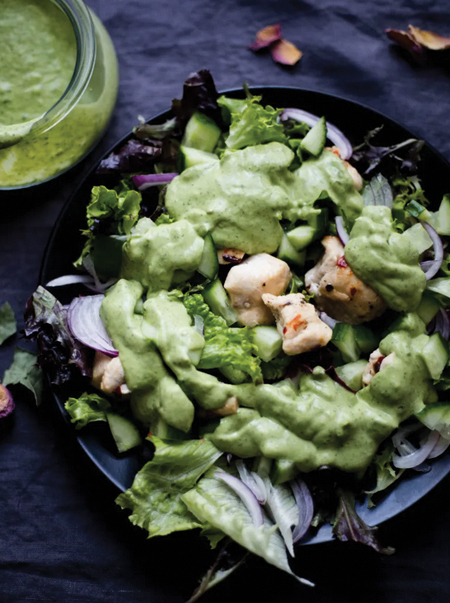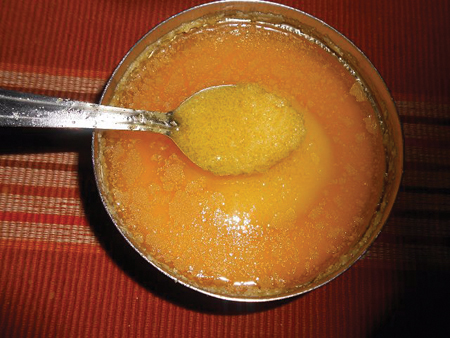Khabar Magazine. January 2024 print issue.
Whenever I visit India, I can’t help but admire the slim waistlines and petite figures of the beautiful ladies who cook and clean around homes. I asked one of them what her secret was, other than the fact that she is quite physically active all day long. The woman, who was around 40 and had two teen kids, responded, “Madam, all I eat is daal, sabzi, and roti.” That simple!

In contrast, I know a group of women, also in their 40s, who are constantly obsessing about fitness and health. Their nutrition consultants have them on fad diets and enrolled with personal trainers—striving for the physique that their domestic help seem to maintain without any effort. My friends who regularly visit weight loss clinics are told to eat lots of salads, bland and steamed vegetables, sprouted grains, and no carbohydrates. Ah, but they are allowed one cheat day a week to binge on chaat, samosa, or whatever they crave! Such yo-yo extremes are not necessary and could be harmful.
Extreme measures such as sustaining on bland steamed veggies may be needed in some cases where one is trying to detox or heal an illness, but most of us can maintain good health with just a few tweaks in our daily choices. Indian food often gets a bad rep but is, in fact, packed with flavor and nutrition. It can be calorie-dense or waist-friendly, depending on what you eat and how it is prepared. Heavily spiced, creamy curries, and deep-fried appetizers served at most Indian restaurants and parties don’t seem to help with this. But there are also hundreds of vegetarian options that are low fat and low carb.
Here are a few ways you can make an easier transition to eating healthier without sacrificing flavors and comforts of homecooked Indian food.

Ghar Ka Khana
- Eating at home makes it easier to control what is in your food. Whenever possible, carry homemade lunch to work or school as well. Many Bollywood actors take their own nutrition-rich Indian meals to film sets and even to parties!
- Purchase good quality ingredients, especially animal proteins such as fish and chicken. Organic, grass-fed, and wild-caught tend to be more expensive but also contain less hormones and chemicals.
- Eating salad does not have to be boring and tasteless. Simply add Indian seasonings and chutneys instead of traditional creamy dressings. I love mint chutney in mine!
- Extra virgin olive oil (EVOO) is best for low heat and so a healthier option for tadka (chhonk) that most Indian cooking requires. Ghee, too, in small quantities is a good option as it provides healthy fat that is rich in Omega-3 fatty acids.
- Avoid deep frying. Instead, Indian snacks such as samosa and pakora can be baked. An air fryer helps reduce the use of oil and provides great texture to paneer pakora, tandoori gobi, chili chicken, and more.
- Avoid cooking creamy curries that tend to use heavy cream, coconut milk, or excessive ghee. Use water, low-fat yogurt, or oat milk instead to thin the curries.
- If you have a crock pot or pressure cooker, slow cook lentils until they reach a natural creamy texture. To make dal makhani, just finish the cooled-off stew with a few spoons of low-fat yogurt for color and creaminess.
- Whole-leaf vegetables will fill you up with fewer calories than lentils and grains will. Even when cooking daal or chana, you can load it up with spinach and kale for a bit more roughage.
- The ancient science of Ayurvedic cooking utilizes six flavors: sweet, sour, salty, bitter, pungent, and sour. If you include all of these in at least one of your meals each day, you will not have any food cravings.
- Adding fresh curry leaves, mango powder, tamarind, cumin, and whole spices has health benefits and reduces the need for salt. Use good quality, single-origin products that have more flavor and are sustainably sourced.
- Grill outdoors or in a terracotta tandoor pot in the oven. The intense heat reduces cooking time and retains the tenderness of meats and nutrition of vegetables without the need for oil and butter.
- Avoid unnecessary calories from breads like rich naans, fried pooris, and parathas. Use a Rotimatic robotic roti maker to easily make homemade roti with whole wheat multigrain flour within minutes.
- When cooking South Indian specialties like idli and dosa, use healthier proteinrich flour such as ragi, chana dal and brown rice.
- Start planning your weekly meals in advance. If you don’t, then cravings will have you order take-out or take the easy way out with unhealthy choices.
Eating Out
- When dining out at Indian restaurants, make sure to observe self-control and mindfulness. Instead of ordering by courses, opt for a thali where you get a well-rounded sampling to tease your tastebuds. Ask to hold back on any fried foods, naan, fat, and cream-rich curries and instead substitute more salads and stir-fried dishes instead.
- Don’t be tempted to finish your plate. Make it a point to take home leftovers so you don’t overeat.
- Avoid dishes like pakora, butter chicken, poori, naan, and desserts. Some healthier options that most Indian restaurant menus offer are dhokla, idli, chana masala, daal tadka, aloo gobhi, baingan bharta, and tandoori chicken.
Anytime Tips
- Don’t start your day with refined sugar. Avoid sugar in your chai and coffee if you can. Even some nut milk brands have sweeteners in them, so check labels.
- When snacking, avoid processed foods such as biscuits, mixtures, namkeen, etc. Instead, opt for salt-free nuts, and dried and fresh fruits.
- Reduce your portion size by picking a smaller plate or bowl, and avoid reaching out for seconds.
- Eat consciously in silence, not distracted by television or smartphones. Allowing yourself to only focus on eating will help register the brain earlier when your belly is full.
- In our culture, we tend to eat dinner very late. Dinner should be consumed no later than 7 p.m. or three hours before bedtime. Intermittent fasting for at least 12 hours also has potential health benefits for energy levels and weight loss.
While many of us resolve to eat better in the New Year, it certainly doesn’t have to be tasteless. Spices and flavors found in Indian cuisine are meant to uplift your mood and provide well-rounded nutrition. Just follow the simple rule of consuming less saturated fat, oil, and sugar.
~ Written for and published by Khabar Magazine. All rights reserved.